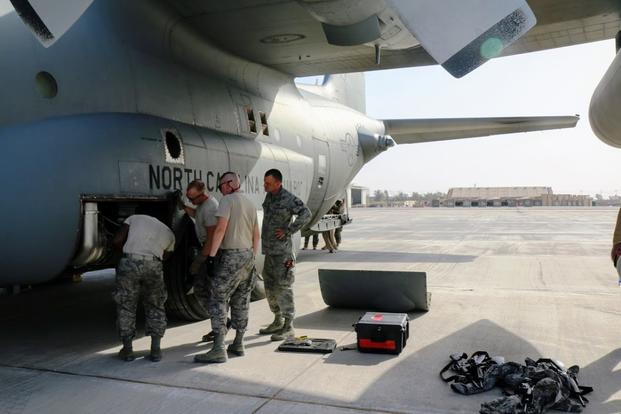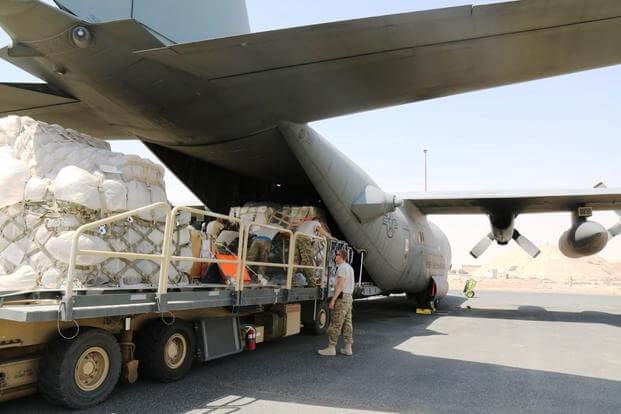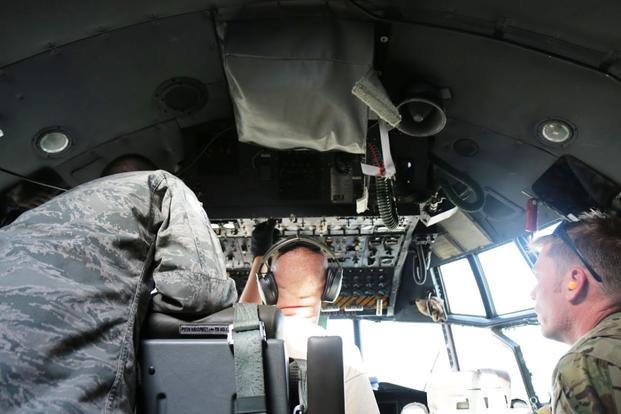ABOARD A U.S. MILITARY AIRCRAFT IN IRAQ -- "Man, the s--- we do to keep these things flying."
That's how the conversation went inside the old C-130H3 temporarily stuck on an airfield in Iraq as a handful of maintainers and flight crew members speedily worked to fix a bogged down engine.
Military.com on Wednesday climbed aboard the C-130 Hercules on a 12-hour operation to several locations in Iraq. Officials at the 386th Air Expeditionary Wing, based elsewhere in Southwest Asia, invited this reporter on the trip under the condition last names, specific locations, tactics and procedures not be disclosed.
Related content:
- Flying with the 'Blue Collar Guys' on a C-130 Mission in Iraq
- General: US Pilots Made the Call to Shoot Down Syrian Aircraft
- The F-22 in Syria: Deconflicting, not Dog-Fighting
Minutes after landing at the first location, the engines decelerated. Tech. Sgt. Justin, sitting third chair in the cockpit as the flight engineer, knew that wasn't a good sign.
"Punch it, punch it, c'mon!" he said, switching various knobs overhead and lamenting to himself to bring the engines back.
No dice.
The weather wasn't on his side, either. On the airstrip, the wind whipped past at 25 knots -- about 30 miles per hour -- and the sun baked the flightline to 118 degrees Fahrenheit. Plus, the position of the C-130 sat meant air and sand were blowing into the aircraft's exhaust.
The auxiliary power unit was out.
"Get that maintenance unit back here," said Maj. Joe, the crew's mission commander and pilot.
The crew for the flight included pilots, a navigator, a flight engineer and loadmasters, all of whom hailed from the National Guard's 156th Airlift Squadron in Charlotte, North Carolina. In theater, they're part of the 737th Expeditionary Airlift Squadron.
The mission was their last in the Middle East before returning home, and the last for this C-130 unit overall before the 156th transitions to the C-17 Globemaster III aircraft this fall.
"Every other mission" tends to "run smoother than this," Joe said.
By sheer luck, the 156th was transporting a handful of 386th Expeditionary Aircraft Maintenance Squadron members in Iraq to fix an already-limp C-130 parked nearby -- also a casualty of bogged down engines, explained as overrunning the engines in a hot environment, Justin said.
"But that was because the [other] plane flamed out an engine. They saw sparks fly, I think," said Capt. Ashley, the navigator.
This C-130 from the 156th flew or sat through eight sandstorms during the crew's deployment, Ashley said.
"It's no secret these planes take a beating out here," he said.
The 'Get-Dirty' Mission
Despite regularly taking such beatings, the C-130 serves as the airlift workhorse of Operation Inherent Resolve -- the Pentagon's name for the anti-Islamic State campaign -- and has for many years of operations in the Middle East.
"Tactical airlift, it's the get-dirty, deploy-a-lot-type mission," said Col. Charles D. Bolton, the 386th commander.
"It's not about how many missiles you put on a plane, what target you're going to go bomb -- it's what missiles or people you're going to put in the plane to take to this location," he said.
Bolton said as the ISIS fight moves, the airlift mission moves with it.
"As you can imagine, we go where the fight is," he said. "When Mosul's the fight, then most of the assets are dedicated to that; but as the Iraqis have almost completed that, then the fight has shifted to Raqqa [Syria].
"As you finish over here, you move everybody over there," he said. "We'll go wherever -- we do whatever."
And the air crews will do that despite incessant setbacks.
Suiting Up
As the cockpit crew watched out the C-130's front windows for anything suspicious while the Hercules descended, they suited up with protective armor, per protocol.
After landing, maintainers worked within the front panel and the Fly-Away Security Team, security forces airmen known as FAST, kept watch -- as they do at all the locations while traveling along in the C-130 for the flight.
"I'll throw my armor on you if you ever feel unsafe," Ashley said to this reporter as she ventured outside to see the commotion.
Tech. Sgt. Chad Wink, a 386 EAMXS engine mechanic, said they figured out the problem involved the fuel holding relay and ignition holding relay within the electrical control box, which provides power to the circuits they control.
The parts were replaced -- the maintainers had supplies to fix the other C-130 and the156th's ended up getting priority -- and the mission resumed.
Full Ramp
The flight plan required almost a handful more stops within Iraq to move nearly 100 people including special operations forces, allies and civilians -- and roughly 15 tons of cargo such as ammunition, tactical equipment, building materials, fuel, food, blood packs.
All of the cargo was destined for the frontlines of the fight against the Islamic State.
With two C-130s temporarily stranded at the base, the ramp -- the area where aircraft are loaded and unloaded -- was considered full and arriving planes weren't able to land.
But thanks to the relatively quick work of the maintainers, just 45 minutes after landing, the engines revved back up and the aircraft took to the skies. In the air, Joe said the C-130 was only six minutes behind schedule -- and the crew made up for lost time.
Joe later reflected: "If [maintenance] wouldn't have been with us, or if that part wasn't with them, we wouldn't [have gone] anywhere."
"Someone is on this run every day," he said, "[and] maintainers deserve a lot of credit" for making it happen.
-- Oriana Pawlyk can be reached at oriana.pawlyk@military.com. Follow her on Twitter at @Oriana0214.

































